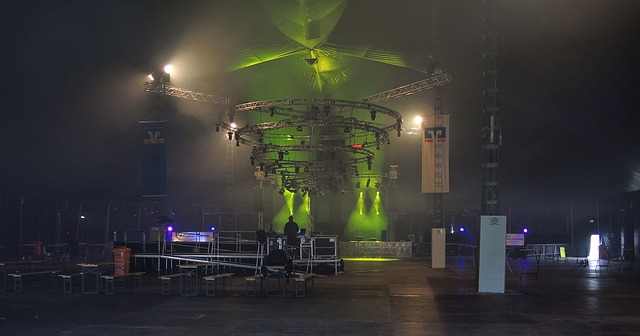Event planning for local businesses is crucial for making a strong impact at trade shows and expos. It's not just about visibility but ensuring that participation aligns with broader business objectives, leading to tangible outcomes. Local businesses should target events where their ideal customers and industry influencers are present to build valuable connections. Pre-event preparation involves identifying key attendees, customizing marketing materials, and preparing engaging content for them. Utilizing local resources, such as working with area suppliers and securing community support, can enhance a trade show booth's appeal by highlighting regional themes or products. Post-event analysis is vital for evaluating success and informing future strategies, including tracking sales performance and gathering attendee feedback. Strategic event planning for local businesses ensures purposeful engagement, with clear objectives and measurable results. It also requires selecting appropriate venues that offer accessibility, capacity, and necessary facilities and support, as well as precise on-site coordination. Incorporating advanced technologies like virtual or augmented reality can elevate the trade show experience. Post-event analysis allows businesses to measure ROI through sales figures, media coverage, and long-term brand recognition, providing insights for refining event strategies and ensuring a more significant impact at future events.
Local businesses eager to elevate their market presence and forge meaningful industry connections should consider strategic trade show participation. This article delves into optimizing local impact through meticulous event planning, detailing the essentials of executing successful expos. From crafting a captivating booth experience to the logistical nuances of venue selection and on-site coordination, each section offers actionable insights tailored for enhancing your trade show engagement. Post-event analysis is equally crucial, providing the metrics to measure success and refine future endeavors. Embark on this guide to ensure your next local business trade show leaves a lasting impression and drives tangible results.
- Maximizing Local Impact: Strategic Planning for Trade Show Participation
- The Logistics of Local Trade Show Execution: Venue Selection to On-Site Coordination
- Crafting a Compelling Booth Experience for Trade Shows and Expos
- Post-Event Analysis: Measuring the Success of Your Local Business Trade Show Participation
Maximizing Local Impact: Strategic Planning for Trade Show Participation

For local businesses aiming to maximize their impact at trade shows and expos, strategic event planning is paramount. It’s crucial to align the trade show objectives with the business goals, ensuring that participation yields tangible benefits beyond mere brand exposure. By meticulously selecting events that cater to the target audience, these businesses can effectively network with potential clients and partners. Pre-event planning involves identifying key decision-makers expected at the expo, tailoring marketing collateral to address their specific needs, and preparing demonstrations or presentations that resonate with their interests.
Furthermore, leveraging local resources such as suppliers, community support, and promotional platforms can enhance a trade show presence. Local businesses should capitalize on these assets by incorporating regional themes or products into their booth displays to attract attendees and differentiate themselves from competitors. Post-event analysis, including feedback collection and sales tracking, is essential for measuring the success of the trade show participation and refining strategies for future events. This data-driven approach ensures that local businesses not only attend but also actively participate in trade shows and expos with a clear purpose and measurable outcomes.
The Logistics of Local Trade Show Execution: Venue Selection to On-Site Coordination

The logistics of executing a successful local trade show require meticulous event planning tailored to the unique needs of regional businesses. Venue selection is pivotal, as it dictates accessibility and capacity for attendees, as well as the practicalities of setting up exhibits. The chosen venue must align with the trade show’s objectives, offering sufficient space, appropriate facilities, and technological infrastructure to support the array of local business participants. Once the site is secured, on-site coordination takes center stage. This involves detailed planning for the layout of booths, scheduling of events, and management of logistics such as utilities, security, and waste removal. Effective on-site coordination ensures seamless interactions between exhibitors, attendees, and service providers, fostering an environment where local businesses can showcase their products and services effectively. The integration of technology, such as virtual reality or augmented reality experiences, can further enhance the trade show’s appeal and provide a platform for businesses to demonstrate innovation and industry leadership. This requires event planners to be adept at leveraging both physical space and technological tools to create an immersive experience that resonates with the local business community.
Crafting a Compelling Booth Experience for Trade Shows and Expos

Crafting an engaging and memorable booth experience at trade shows and expos is a critical aspect of event planning for local businesses aiming to stand out in competitive environments. The design of the exhibit space should not merely showcase products or services but also tell a compelling story that resonates with attendees. Local businesses can enhance their presence by incorporating interactive elements, such as live demonstrations, which allow potential customers to experience the benefits firsthand. Utilizing multisensory approaches, including touchable displays and engaging audio-visual content, can create an immersive environment that captures attention and fosters deeper connections with the brand.
Moreover, strategic placement of informational materials and staff training are essential components in delivering a consistent and professional booth experience. Staff members should be well-versed in product knowledge and skilled in customer engagement to answer queries effectively and guide attendees through the exhibit with confidence. By integrating personalized touches, such as branded merchandise or exclusive offers for show attendees, local businesses can create a memorable interaction that encourages follow-up conversations and potential sales post-event. Effective event planning for local businesses at trade shows and expos hinges on the ability to deliver an experience that is both informative and enjoyable, setting the stage for long-term customer relationships and brand loyalty.
Post-Event Analysis: Measuring the Success of Your Local Business Trade Show Participation

post-event analysis, trade show success, local business participation, event planning strategies, measuring impact, evaluating ROI, actionable insights, data-driven decision making.
Following a trade show, local businesses must engage in meticulous post-event analysis to gauge the effectiveness of their participation. This process is pivotal for refining event planning for local businesses and optimizing future engagements. By dissecting attendance figures, lead generation numbers, customer interactions, and feedback, businesses can pinpoint which aspects of their trade show presence resonated with attendees and which areas require improvement. Collecting data on booth traffic, engagement with promotional materials, and the number of qualified leads captured allows for a granular understanding of performance metrics. This detailed examination enables businesses to make informed, data-driven decisions that enhance their event planning for local enterprises and contribute to a more successful trade show experience overall.
Incorporating post-event analysis into the event planning for local businesses is not merely about evaluating immediate outcomes but also understanding the long-term impact on brand awareness and customer relationships. By analyzing follow-up conversations, sales generated post-event, and media coverage received, businesses can measure the true return on investment (ROI) of their trade show participation. This comprehensive review process offers actionable insights that can be implemented in subsequent trade show strategies, ensuring a more impactful presence and a clearer path toward achieving marketing and sales objectives. Engaging in post-event analysis is an essential component of effective event planning for local businesses, providing a roadmap for success that extends well beyond the confines of the expo floor.
In conclusion, local businesses can significantly enhance their market presence and strategic positioning through meticulous event planning for trade shows and expos. By carefully selecting venues and mastering on-site coordination, companies can create a captivating booth experience that not only attracts attendees but also fosters meaningful connections. Post-event analysis serves as an invaluable tool to gauge the effectiveness of participation and inform future strategies. The insights gained from this process ensure that each trade show appearance is more impactful than the last, solidifying the participant’s standing in their industry. Local businesses looking to elevate their engagement in these events should consider these comprehensive approaches to maximize their local impact and drive business growth.



